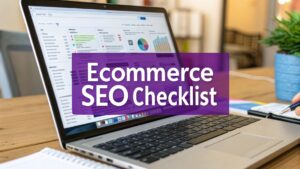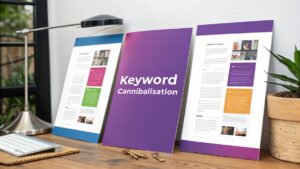A proper content strategy isn't about guesswork; it's about having a documented plan that gives every single piece of content a job to do. It’s the difference between just making noise online and actually getting tangible results for your business.
Building Your Foundation for a Winning Content Strategy
Before you even think about writing a blog post or shooting a video, you need clarity. What does success actually look like for your business? We're moving away from random acts of content and toward a structured, purposeful approach.
Having this strategy written down is the bedrock of success. It’s no surprise that in the UK, 81% of marketers see content marketing as a core part of their business strategy. Better yet, research shows that companies with a documented plan achieve a 33% higher return on investment (ROI) compared to those winging it. This just goes to show how crucial it is to formalise your efforts instead of running ad hoc campaigns.
Set Clear and Actionable Goals
Every piece of content needs a purpose. Are you trying to build brand awareness in Cambridgeshire? Generate qualified leads for your e-commerce shop? Or maybe improve loyalty among your existing customers? Without a clear destination, you’re just creating content for content's sake.
To give your goals some real structure, the SMART framework is your best friend. It forces you to get specific and ensures your objectives are trackable from the get-go.
Lots of businesses I talk to have vague goals like "get more traffic." The SMART framework helps turn those fuzzy ideas into a concrete plan.
The table below breaks down how you can apply this framework to your content goals, with some practical examples for a UK-based business.
The SMART Content Goal Framework
| Component | Description | Example Content Goal |
|---|---|---|
| Specific | Your goal should be unambiguous and clear. | Increase organic blog traffic from UK-based SMEs in the manufacturing sector. |
| Measurable | Define exactly how you will track progress. | Achieve a 20% increase in organic traffic and generate 50 new leads per month. |
| Achievable | Be realistic. Your goals should be a stretch, but still within reach. | Secure 10 high-quality backlinks from industry-relevant UK websites. |
| Relevant | Ensure your content goals align directly with wider business objectives. | Drive a 15% increase in demo requests for our new software product. |
| Time-bound | Set a clear deadline to create urgency and focus. | Achieve these targets within the next fiscal quarter (by the end of Q3). |
Setting SMART goals is what separates a wish from a genuine plan. It gives you a clear benchmark to measure success against. This level of organisation is a cornerstone of our affordable SEO services for small businesses, where every single action is tied directly to a measurable outcome.
A content strategy without clear goals is like a ship without a rudder. You'll drift along, creating content that looks busy but ultimately goes nowhere. Tie every blog post, video, and social media update back to a specific, measurable business objective.
Define Your Target Audience with Buyer Personas
Once you know what you want to achieve, you need to be crystal clear on who you're trying to reach. This is where detailed buyer personas come in, and for your UK audience, it’s an absolute must. This process goes way beyond simple demographics like age and location.
To build a persona that actually works, you need to get inside their head. What are their biggest professional headaches? What really motivates them to buy something? What online spaces—from specific LinkedIn groups to industry forums—do they actually hang out in and trust?
Let’s imagine a persona we'll call "Marketing Manager Mary" for a B2B tech company.
- Her Role: She runs a small team at a growing SME based in Manchester.
- Her Challenges: She’s constantly under pressure to prove ROI on her marketing spend and is always short on time.
- Her Goals: She needs to find efficient ways to generate high-quality leads without a massive budget to play with.
- Where She Looks for Info: She reads industry blogs during her lunch break, listens to marketing podcasts on her commute, and is active in a few professional LinkedIn groups.
Having this level of deep understanding means every piece of content you create will speak directly to Mary's problems and offer her a genuine solution. It’s how you make sure your content hits the mark from day one.
Auditing Your Content and Analysing Competitors

Before you can map out where you're going, you need to know exactly where you are. This means taking a good, honest look at the content you've already created and sizing up the competition.
This isn't about getting lost in endless spreadsheets. It's about getting clear on your current position so you can make smarter, more strategic decisions moving forward. This two-pronged approach—looking inward at your assets and outward at the market—is fundamental. It stops you from reinventing the wheel and helps you spot golden opportunities you might have otherwise missed.
Taking Stock of Your Existing Content
A content audit might sound daunting, but it’s really just an inventory of what you've got. The goal is to gather everything—blog posts, case studies, videos, guides, even old social media campaigns—to figure out what’s working, what isn't, and where the gaps are.
Start by listing all your key content assets. For each piece, you need to assess how it’s performing against your business goals. I recommend sorting them into three simple buckets:
- Top Performers: Pinpoint the content that drives the most traffic, brings in leads, or gets the most engagement. These are your crown jewels, and they tell you exactly what your audience loves.
- Underperformers: Find the articles and pages that fell flat. Was it a bad topic choice, poor optimisation, or is it just outdated? Be ruthless here.
- Content Gaps: What crucial topics have you completely ignored? Think about your ideal customer's pain points. Are there questions they're asking that you haven’t answered yet?
Once you’ve categorised everything, you can decide what to do with it. This is where the simple "Keep, Update, or Delete" framework comes in.
Your existing content is a goldmine of data. An audit reveals what your audience actually values, not what you think they value. Use these insights to double down on what works and stop wasting time and money on what doesn't.
The Keep, Update, or Delete Framework
Not all content is created equal, and your audit will make that painfully clear. The next step is deciding the fate of each piece.
- Keep: This is for your high-performing, evergreen content that's still relevant and accurate. These pieces are your workhorses, so just give them a quick check and keep promoting them.
- Update: Here’s where the real opportunity lies. Content on a solid topic that's just outdated, a bit thin on detail, or poorly optimised for search can be refreshed for a massive performance boost.
- Delete: Some content is just beyond saving. If it's inaccurate, totally irrelevant to your current business goals, or gets zero traffic, it might be time to say goodbye. Just be sure to redirect the URL to a more relevant page.
This systematic clean-up does wonders for your website's overall quality in the eyes of both users and search engines. It’s a core part of many successful content marketing best practices because it ensures your efforts are always focused and effective.
Analysing Your Competitors' Strategies
Now that you have a clear picture of your own content landscape, it’s time to look over the fence at your competitors. The goal isn't to copy them—it's to strategically understand their playbook so you can find your own unique angle.
First, identify three to five of your direct competitors in the UK market. Dive deep into what they're doing well and, just as importantly, where they might be vulnerable. Ask yourself:
- What topics are they hammering? Make a note of the themes and keywords they target again and again.
- Which content formats do they prefer? Are they all-in on video, or do they stick to long-form articles and infographics?
- Where is their content winning? Look at which pieces get the most social shares, comments, and backlinks. Tools like Ahrefs or Semrush are brilliant for digging up this data.
- What's their tone of voice? Is it formal and corporate, or casual and conversational?
This analysis will quickly reveal patterns and—crucially—gaps. Maybe your main competitor pumps out excellent blog posts but hasn't touched video. That could be a massive opportunity for you to own a different format and capture an audience they're completely ignoring. Let this analysis directly shape your content plan, helping you create something that truly stands out.
Mapping Content to Your Customer Journey

Truly effective content doesn’t just get published; it lands in front of your audience at the exact moment they need it. This is where mapping content to the customer journey becomes a game-changer, turning random touchpoints into a seamless, guided experience.
Think of it as the difference between shouting into a crowded room and having a helpful, one-on-one conversation. By aligning what you create with the three core stages—Awareness, Consideration, and Decision—you build a natural pathway that nurtures potential customers from their first casual glance to a confident final purchase.
This structured approach gives every single piece of content a specific job to do, ensuring you’re answering the right questions at the right time. The result is a much more cohesive and persuasive brand story that builds real trust and drives action.
The Awareness Stage: Attracting New Prospects
At the very top of the funnel, your audience isn't looking for a sales pitch. Not yet. They have a problem or a question, and they’re turning to search engines or social media for answers. Your mission here is simple: be the helpful expert who provides the solution.
Content at this stage should be educational, engaging, and broadly appealing. It’s not about your product; it’s about their problem. For example, a local accountancy firm in Cambridgeshire could create a blog post titled "5 Common Tax Mistakes Small Businesses Make."
Here are some classic Awareness stage content formats:
- Helpful blog posts that answer common "how-to" or "what is" questions.
- Engaging social media content like short videos or infographics that are easily shareable.
- Simple checklists or guides that offer quick, practical value without asking for much in return.
The goal is to get on their radar by being genuinely useful. This establishes your brand as a credible resource long before they’re even thinking about buying.
The Consideration Stage: Building Trust and Authority
Once someone is aware of their problem and knows you exist, they enter the Consideration stage. Now, they're actively researching and comparing potential solutions. Your content needs to shift from general advice to more in-depth, solution-focused information.
This is your chance to build trust and really demonstrate your expertise. You need to show them why your approach or solution is the right one. You can start to introduce your brand more directly, but the focus has to remain on education and value.
This stage is all about demonstrating your expertise and building a case for your solution. People are weighing up their options, and your content must provide the detailed insights they need to move forward with confidence.
Let's say a marketing manager is evaluating different SEO agencies. Content that would help them includes:
- In-depth case studies showcasing how you helped a similar business achieve specific results.
- Detailed webinars or guides that explore a complex topic, positioning you as a thought leader.
- Comparison sheets that fairly evaluate different approaches or tools in your industry.
Once you get a handle on your customer journey, you can layer in more advanced personalized content marketing strategies to deliver even more relevant information at this critical stage. That level of customisation can make a huge difference in engagement and help guide prospects toward a decision.
The Decision Stage: Driving the Final Conversion
Finally, at the Decision stage, your prospect is ready to make a choice. They’ve done their research, narrowed their options, and now they just need that final bit of reassurance that they’re making the right call.
Your content here should be highly targeted and product-focused. It's designed to overcome any lingering doubts and make it as easy as possible for them to convert. This is where you can be more direct with your call-to-action, whether that’s booking a demo, requesting a quote, or making a purchase.
Effective content for this final stage includes:
- Customer testimonials and reviews to provide powerful social proof.
- Product comparison pages that highlight your unique selling points against competitors.
- Free trials, demos, or consultations that offer a risk-free way to experience your service first-hand.
By carefully mapping your content to each of these stages, you create a journey that feels logical and supportive. You're not just selling; you're guiding them to the best possible solution for their needs.
Choosing the Right Content Formats and Channels
You’ve mapped out the customer journey. Great. Now comes the fun part: figuring out what you're going to create and where you're going to put it. This isn't about blasting your message everywhere and hoping something sticks. It’s about being deliberate. The goal is to choose content formats and distribution channels that line up perfectly with what you want to achieve and where your audience actually spends their time.
Getting the format right is half the battle. Think about it: a potential customer in the Awareness stage, maybe scrolling on their phone during their commute, isn't going to read a 4,000-word white paper. But a snappy 60-second explainer video? That they'll watch. If you choose the wrong format, all your brilliant insights could go completely unnoticed.
Matching Content Formats to Your Audience
The secret is to put yourself in your audience's shoes. If your ideal customer is "Marketing Manager Mary," who's constantly juggling tasks, a podcast she can listen to while clearing her inbox is a much better bet than a long-form article demanding her undivided attention.
The message itself also dictates the format. A complex B2B service often needs a detailed case study or a webinar to do it justice. On the other hand, if you’re selling a visually stunning product, Instagram stories or a Pinterest board are your best friends. The format should always serve the message, never the other way around.
Different formats are built to do different jobs. A long article might be a traffic-driving machine, but a video is often what seals the deal for a lead.

This image drives the point home: long-form content is fantastic for growing traffic, but if you want to get people talking and converting, more interactive formats like video tend to win out.
The data backs this up. We're seeing a clear trend in the UK where audiences are demanding more depth and visual engagement. The average blog post is now 1,427 words long—that’s over 70% longer than a decade ago. It shows people want substance. At the same time, 83% of UK consumers say they want to see more video content from brands. And don't forget infographics; they can boost website traffic by 12% simply because they are 30 times more likely to be read than a wall of text. You can dive deeper into these content marketing statistics and find more insights to guide your strategy.
To make this crystal clear, let's map out which content formats work best for each part of the customer journey here in the UK.
Matching Content Formats to Customer Journey Stages
| Journey Stage | Primary Goal | Recommended Content Formats |
|---|---|---|
| Awareness | Attract attention & introduce your brand | Blog posts, short videos, infographics, social media updates |
| Consideration | Educate & build trust | Case studies, webinars, in-depth guides, email newsletters |
| Decision | Convert leads into customers | Free trials, demos, customer testimonials, detailed pricing pages |
| Loyalty | Retain customers & encourage advocacy | Exclusive content, user-generated content, customer success stories |
This table isn't a rigid rulebook, but it’s a solid starting point for aligning your creative efforts with your customer's mindset at each step.
Now that you have a better idea of what to create, let's talk about where to share it.
Selecting the Right Distribution Channels
Creating amazing content is one thing, but getting it in front of the right eyeballs is another. This means picking channels where your audience is already active and open to hearing from you. Don't blow your budget trying to promote B2B thought leadership on TikTok if your target CEOs are scrolling through their LinkedIn feeds all day.
Think of your channels as different rooms at a party. You wouldn't try to have a deep, technical conversation in the middle of the dance floor. Match your content's tone and depth to the environment of the channel for the best results.
Here’s a quick rundown of how to approach some of the most popular channels:
- Your Company Blog: This is your home base. It’s the perfect spot for long-form content that builds your SEO authority and captures leads. Every good content strategy needs a strong blog at its core.
- Email Marketing: Nothing beats email for nurturing leads who are in the consideration and decision stages. You can send highly personalised content, like case studies or special offers, directly to people who are already engaged.
- LinkedIn: For anyone in the B2B space in the UK, LinkedIn is non-negotiable. It's the place to share industry insights, company news, and expert articles to establish yourself as a leader in your field.
- Instagram/TikTok: These visual-first platforms are gold for B2C brands. They're brilliant for creating buzz and building awareness through behind-the-scenes videos, product showcases, and user-generated content campaigns.
- Industry Forums & Groups: Never underestimate the power of niche communities. Getting involved in specific subreddits or private Facebook groups can be a powerful way to build trust and establish yourself as a go-to expert.
The most effective strategy is often a "hub and spoke" model. Your blog is the central hub where your most valuable, in-depth content lives. Your other channels—the spokes—are then used to promote and repurpose that core content for different audiences and contexts. This keeps your efforts focused and ensures you’re getting the most bang for your buck.
Building a Sustainable Content Creation and Promotion Plan

A brilliant strategy is useless if it just gathers dust. The real work starts when you turn those well-researched plans into a steady stream of valuable content that actually reaches your audience. The goal is to build a system that’s both effective and sustainable, one that helps you avoid burnout while still making a real impact.
It all boils down to organisation. A content calendar is the backbone of any successful operation, acting as your single source of truth for what gets published, where, and when. This simple tool turns an abstract strategy into a concrete, actionable schedule.
Organising Your Content Production
A content calendar isn't just for scheduling blog posts; think of it as your entire production roadmap. Whether you're a one-person show or managing a small team, a calendar provides the structure you need to stay on track and keep the momentum going.
Your calendar should map out the whole workflow, from the initial idea right through to the final promotional push. At a bare minimum, each entry should include:
- Publish Date: When the content is scheduled to go live.
- Content Title/Topic: The working title or a clear description of what it’s about.
- Content Format: Is it a blog post, a video, a case study, or a social media campaign?
- Author/Owner: Who is responsible for getting this piece created?
- Status: A simple tracker to see where things are at (e.g., Idea, In Progress, Ready for Review, Published).
This level of detail ensures everyone knows what they’re responsible for and when it’s due. It cuts out the last-minute scramble and keeps your content pipeline flowing smoothly, turning your strategy into a reliable engine for growth.
Creating Efficient Workflows
With your calendar in place, the next job is to define your creation process. An efficient workflow is absolutely critical, especially for small businesses where time is always in short supply. It breaks the entire content lifecycle into manageable steps, which is key for maintaining quality and consistency.
A typical workflow might look something like this:
- Ideation: Brainstorming and researching topics that align with your strategy.
- Briefing: Creating a detailed outline that covers the target keyword, audience, key points, and call-to-action.
- Drafting: The actual writing or creation of the content itself.
- Review & Editing: Checking for quality, accuracy, and making sure it fits your brand voice.
- Approval: Getting the final sign-off before the content is scheduled.
- Publication: Publishing the content on the chosen channel.
A structured process like this removes any guesswork and empowers your team to work effectively. It’s all about creating a repeatable system that delivers high-quality results every single time, without having to reinvent the wheel.
Creation is only half the battle. The most insightful blog post or brilliantly produced video is completely ineffective if no one ever sees it. A smart promotion plan turns your content from a static asset into an active tool for generating traffic and leads.
Amplifying Your Content Through Promotion
Once your content is live, it’s time to make sure people actually see it. A multi-channel promotion strategy is essential for maximising your reach and driving engagement. This usually means a mix of search, social, and email efforts to connect with your audience wherever they hang out online.
For lasting visibility, Search Engine Optimisation (SEO) is your most powerful tool. This involves optimising your content with relevant keywords, building internal links, and making sure your site is technically sound. If you're looking to get started, you can explore our detailed guide on how to do SEO yourself to build a strong foundation.
Social media is another critical channel, especially here in the UK. As of early 2025, a whopping 79% of the UK population (around 54.8 million people) were active on social platforms, making them impossible to ignore for distribution. Instagram, with its 33.4 million UK users, is particularly valuable; short-form video Reels have been shown to get 122% higher reach than static images. This really highlights the importance of tailoring your promotional content to fit the platform. You can find more great insights about the UK's social media landscape on SproutSocial.com.
Finally, don't sleep on your email list. It's one of the few channels you completely own, giving you a direct line to your most engaged audience. Sending out a newsletter with your latest content is a fantastic way to drive repeat traffic and nurture leads who have already shown an interest in what you do. By combining these promotional tactics, you can make sure your valuable content works as hard as possible for your business.
Got Questions About Your Content Strategy?
Even with a solid plan in hand, a few questions always seem to pop up. It's completely normal. Nailing your content strategy often means working through some of the finer points. Let's tackle a few of the most common ones I hear from businesses.
How Often Should I Be Publishing New Content?
This is the classic question, and if I'm being honest, the answer is always: it depends. There’s no magic number that guarantees success for every business. The right frequency for you boils down to a realistic balance of quality, consistency, and the resources you actually have.
Instead of chasing an arbitrary number, focus on finding a sustainable rhythm. Putting out one incredibly helpful, well-researched blog post every single week is miles better than publishing three rushed, flimsy articles just for the sake of it. Consistency is what really builds an audience. People learn when to expect new stuff from you, and that's how you build loyalty.
My advice? Start with a schedule you know you can stick to, even if that’s just one or two core pieces a month. You can always ramp things up later once you've got your process down.
What’s the Real Difference Between Content Strategy and Content Marketing?
It’s so easy to use these terms interchangeably, but they're two sides of the same coin, each with a distinct job.
Think of it like building a house:
- Content Strategy is your blueprint. It’s the high-level why and who. This is the master plan that lays out your goals, defines your audience, and clarifies the core messages you want to get across.
- Content Marketing is the actual construction. It's the hands-on how and where. This is the process of creating, publishing, and promoting your blog posts, videos, and social media updates—all based on that blueprint.
You simply can't have effective content marketing without a solid content strategy pointing the way. The strategy is what ensures every piece of content you create has a clear purpose.
How Do I Know if My Content Strategy is Actually Working?
This is where your SMART goals come back into play. Measuring success isn't about guesswork; it's about tracking the metrics that directly tie back to the goals you set at the very beginning.
If your goal was to boost brand awareness, you’d be looking at things like:
- Growth in your organic traffic
- Social media shares and overall reach
- An increase in people searching for your brand name
But if your goal was all about lead generation, your focus would shift to:
- Conversion rates on your key landing pages
- The number of new email subscribers
- Downloads of your gated content, like eBooks or guides
It's easy to get distracted by "vanity metrics" like raw page views. Don't fall into that trap. Focus on the data that proves your content is delivering real business results, whether that’s bringing in qualified leads or keeping existing customers happy. Checking in on these numbers regularly lets you make smart adjustments instead of just guessing.
Should I Go After Broad Topics or Super-Niche Keywords?
A great content strategy actually needs a bit of both, but where you put your energy depends on your business's current authority and what you're trying to achieve. Broad, high-volume keywords are often incredibly competitive, making them tough for a smaller business to rank for right out of the gate.
This is where niche, long-tail keywords are absolute gold. These are longer, more specific phrases people use when they're much closer to making a decision. For example, instead of just targeting "SEO services," a much sharper target would be "affordable SEO for Cambridge plumbers." Targeting these helps you pull in highly qualified traffic that’s more likely to convert. Our guide on what is long tail keywords dives much deeper into this.
Ultimately, a balanced approach is the way to go. Use those niche keywords to build your authority and capture ready-to-buy leads, and then you can start targeting broader topics as your website's authority grows over time.
Ready to turn strategy into results? At Bare Digital, we specialise in creating and executing bespoke SEO and content strategies that drive real growth for businesses in Cambridgeshire and beyond. Get your free SEO Health Check today and receive a tailored proposal within 24 hours.








